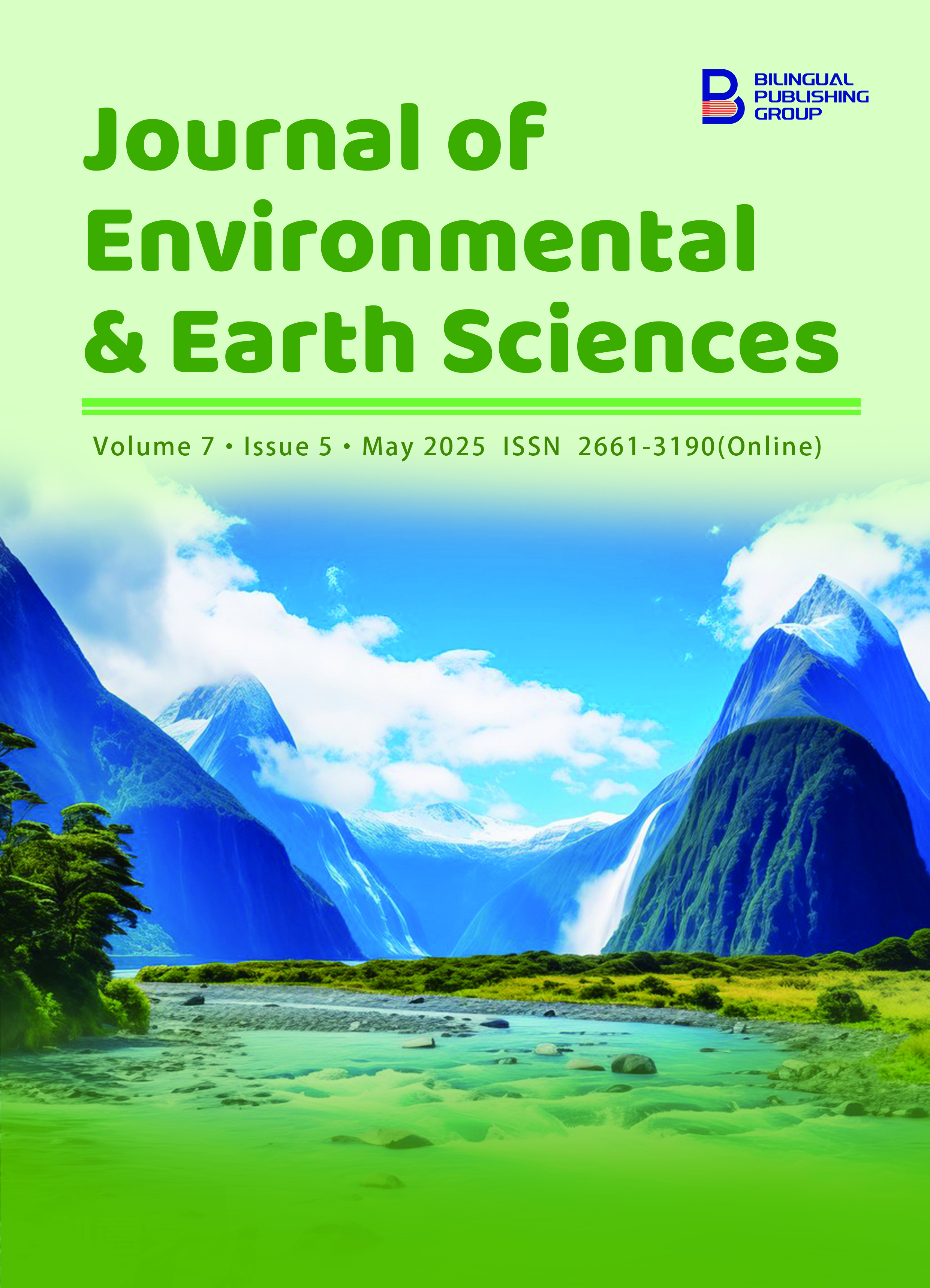
Banana Peel and Beyond: Transforming Agricultural Waste into Eco-Friendly, Biodegradable Plastics
DOI:
https://doi.org/10.30564/jees.v7i5.8588Abstract
The management of agricultural wastes is essential for resource conservation and environmental sustainability. Due to escalating worries regarding plastic pollution and the surging expenses linked to petroleum-based plastics, there has been a notable transition towards the creation of biodegradable alternatives sourced from natural materials. Biofibres and bioplastics, especially those derived from agricultural waste, have garnered significant attention for their prospective uses in food packaging, biomedical sciences, and sustainable manufacturing. This study examines the viability of employing banana peel as a natural and environmentally sustainable raw material for the production of biodegradable bioplastic sheets. Due to its abundant polysaccharides and lignocellulosic fibers, banana peel presents advantageous structural and mechanical characteristics for bioplastic manufacturing. Experimental findings demonstrate that bioplastic derived from banana peels has enhanced biodegradability and environmental compatibility relative to traditional synthetic plastics, positioning it as a feasible alternative to mitigate the worldwide plastic waste epidemic. An optimal formulation was constructed using Design Expert software, comprising 55.38 g of banana peel, 27.63 g of fish scales, and 20 g of chitosan powder. This formulation improves the film’s tensile strength, flexibility, and degradation rate, ensuring its efficacy in industrial applications including food packaging and molding. The study’s results highlight the promise of bioplastics made from banana peels as an economical and sustainable alternative, decreasing dependence on petroleum-based plastics and alleviating environmental pollution.
Keywords:
Biodegradable Plastics Banana Peel; Fish Scale; Chitosan; Design Expert SoftwareReferences
[1] Nguyen, T.B.T., Ketsa, S., van Doorn, W.G., 2003. Relationship between browning and the activities of polyphenol oxidase and phenylalanine ammonia lyase in banana peel during low temperature storage. Postharvest Biology and Technology. 30, 187–193.
[2] Suharti, P.H., Hendrawati, N., Suharti, A., 2015. Preliminary study of utilization of kepok banana skin waste (musa acuminata balbisiana colla) as a biodegradable film raw material. Jurnal Teknik: Ilmu dan Aplikasi.. 5(1) 22–28.
[3] Beevi, K., 2020. Bioplastic synthesis using banana peels and potato starch and characterization. International Journal of Scientific & Technology. 9(01), 2277–8616.
[4] Bottles, D., Sets, D., Cylinders, M., et al., 2021. Stirring rod, glass paddle end westlab. Available from: https://www.westlab.com.au/labware/labware-n-z/stirring-rods/071607-0001stirring-rod-glass-paddle-end (cited 22 March 2016).
[5] Centre for International Environmental Law, 2021. Plastic and climate: The hidden costs of a plastic planet. Available from: https://www.ciel.org/plasticandclimate
[6] Namdeti, R., Al-Kathiri, D.S.M.S., Rao, G.B., et al., 2025. A critical review of smart materials for efficient water purification: Towards sustainable clean water solutions. Journal of Membrane Science and Research, 11(1), 1–8.
[7] Das, S., 2019. Biodegradable plastics: Eco-friendly plastics. Journal of Medicinal Plants Studies. 7(2), 103–105.
[8] Ghamande, M., Kulkarni, A., Shah, N., et al., 2018. Bio-Plastic (Generating Plastic from Banana Peels). Proceedings of the International Conference on New Frontiers in Engineering, Management, Social Science and Humanities; 25 February 2018; Pune, India. Available from: http://data.conferenceworld.in/25FebEMSSH/9.pdf
[9] Bhatti, H.J., 2021. Laboratory equipment, laboratory ovens - all industrial manufacturers in this category - videos. Available from: https://www.directindustry.com/cat/laboratory-equipment/laboratory-ovens-BQ1802.html (cited 14 May 2020).
[10] Dong, Y., Chen, H., Qiao, P., et al., 2019. Development and properties of fish gelatin/oxidized starch double network film catalysed by thermal treatment and schiff’ base reaction. Polymers. 11(12), 2065.
[11] Gangane, V., Dange, D., Dharme, S., et al., 2021. Manufacturing of bio-plastic from organic or renewable biomass sources of agricultural waste. Available from: https://zenodo.org/record/3947563#.YJfaDLUzZPY (cited 16 July 2014).
[12] Digi-Sense 08077-82 safety-coated liquid-in-glass thermometer, –20 to 150 °C, total immersion. Available from: https://www.globaltestsupply.com/product/digi-sense-08077-82-safety-coated-liquid-in-glass-thermometer-wd-08077-82 (cited 22 December 2012).
[13] Hernández-Carmona, F., Morales-Matos, Y., Lambis-Miranda, H., et al., 2017. Starch extraction potential from plantain peel wastes. Journal of Environmental Chemical Engineering. 5(5), 4980–4985.
[14] Huzaisham, N., Marsi, N., 2020. Utilization of banana (musa paradisiaca) peel as bioplastic for planting bag application. International Journal of Advanced Research in Engineering and Technology (IJARET). 11, 108–118.
[15] Johari, W.L.W., Sultan, N.F.K., 2017. The development of banana peel/corn starch bioplastic film: A preliminary study. Department of Environmental Science. 5(1), 1–6.
[16] Kasmuri, N., Muhammad Abu Zait, S., 2018. Enhancement of bioplastic using eggshells and chitosan on potato starch based. International Journal of Engineering & Technology. 7(3), 110.
[17] Li, Z., Guo, K., Lin, L., et al., 2018. Comparison of physicochemical properties of starches from flesh and peel of green banana fruit. Molecules. 23(9), 2312.
[18] Suman, R., 2021. We depend on plastic. Now we’re drowning in it. Available from: https://www.nationalgeographic.com/magazine/article/plasticplanet-waste-pollution-trash-crisis (cited 22 November 2017).
[19] Tibolla, H., Pelissari, F., Martins, J., et al., 2019. Banana starch nanocomposite with cellulose nanofibers isolated from banana peel by enzymatic treatment: In vitro cytotoxicity assessment. Carbohydrate Polymers. 207, 169–179.
[20] Tyuftin, A., Kerry, J., 2021. Gelatin films: Study review of barrier properties and implications for future studies employing biopolymer films. Food Packaging and Shelf Life. 29, 100688.
[21] Feroz, S., Venkateswara Rao, S., Nageswara Rao, L., 2009. Biological treatment of industrial wastewaters using up-flow Anaerobic contact filter. Journal of the Institution of Engineers (India). 89, 3–7.
[22] Salim AL-Reyamia, N., Shaik, F., Lakkimsetty, N., 2020. Environmental impact on usage of treated effluents from ISTP for irrigation. Journal of Water Process Engineering. 36, 101363. DOI: https://doi.org/10.1016/j.jwpe.2020.101363
[23] Al-Rahbi, E.S., Lakkimsetty, N., Kavitha, G., et al., 2022. Experimental studies on treatment and reuse of grey water using wetland adsorption system. AIP Conference Proceedings. 2463, 030006. DOI: https://doi.org/10.1063/5.0080256
[24] Lakkimsetty, N.R., Shaik, F., Gandi, S., et al., 2022. Synthesis, characterization and application of polymer composite materials in wastewater treatment. Materials Today: Proceedings. 59(3), 1726–1734. DOI: https://doi.org/10.1016/j.matpr.2022.04.050
[25] Salih, F., Sakhile, K., Lakkimsetty, N., et al., 2022. Treatment of petroleum wastewater using synthesized hematite (α-Fe₂O₃) photocatalyst and optimization with response surface methodology. International Journal of Environmental Analytical Chemistry. 102(18), 22–26. DOI: https://doi.org/10.1080/03067319.2020.1817422
[26] Salim AL-Reyamia, N., Shaik, F., Lakkimsetty, N., 2020. Environmental impact on usage of treated effluents from ISTP for irrigation. Journal of Water Process Engineering. 36, 101363.
[27] Shaik, F., Mohammed, N., Lakkimsetty, N., 2022. Treatment technologies for the removal of microplastics from aqueous medium. AIP Conference Proceedings. 2463, 030009. DOI: https://doi.org/10.1063/5.008023
Downloads
How to Cite
Issue
Article Type
License
Copyright © 2025 Nageswara Rao Lakkimsetty, Lakshmi Jayanthi Juturi, Amarender Reddy Kommula, Clement Varaprasad Karu, Naladi Ram Babu, Dadapeer Doddamani, G. Kavitha, Rakesh Namdeti

This is an open access article under the Creative Commons Attribution-NonCommercial 4.0 International (CC BY-NC 4.0) License.







 Nageswara Rao Lakkimsetty
Nageswara Rao Lakkimsetty






